Know Your Tree
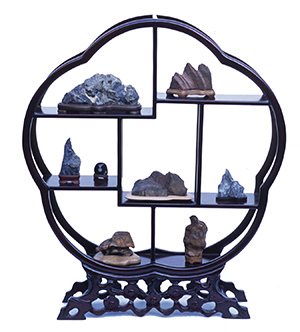
Stones
by Lew Buller
If you are surprised to see an article on stones in this series, stop and think of the full title of the BCI Magazine. It is BCI Bonsai and Stone Appreciation. Stones, usually presented on base, are often used as accessories to bonsai in shows. In some cases, the stones are an exhibit in their own right, either individually if they are large or in a group if they are small.
The stand at left is 17 3/8” tall from the very bottom of the stand to the top. Three of the small stones are owned by my arborist friend, Steve.
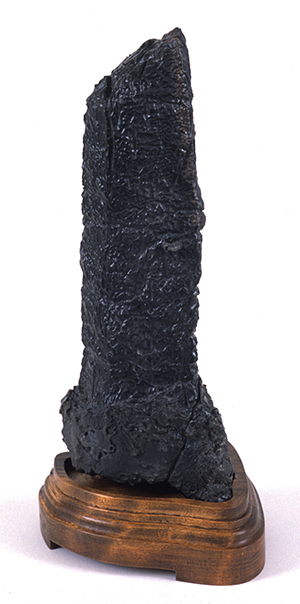
What’s the first thing you think of when you see the photo of the stone above? Unless you say “Egyptian obelisk,” you may have a dirty mind. It’s actually a piece of volcanic debris from the California desert collected over 20 years ago in Lake Hill, an area now closed to collectors. Black is an unusual color for stones. A good friend asked to buy it, saying he had nothing like it in his collection. I told him no, if I sold it, I wouldn’t have anything like it in my collection.
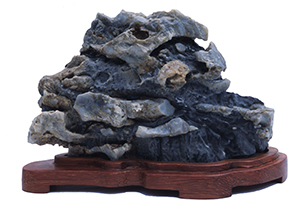
Anyone who has ever had the pleasure of standing under a tin roof during a hard rainstorm will understand the significance of this shelter stone. It takes a good imagination to see all the potentials in stones. I was accustomed to straight lines and 900 corners, with double lines under totals for columns of numbers and had to let go of all of that. Now when I look at the upper right portion, I can see the head of a raptor, an erect crest, a bulging eye, a hooked upper bill meant for tearing flesh, and a bottom bill. The base is Padouk.
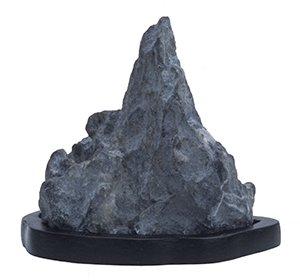
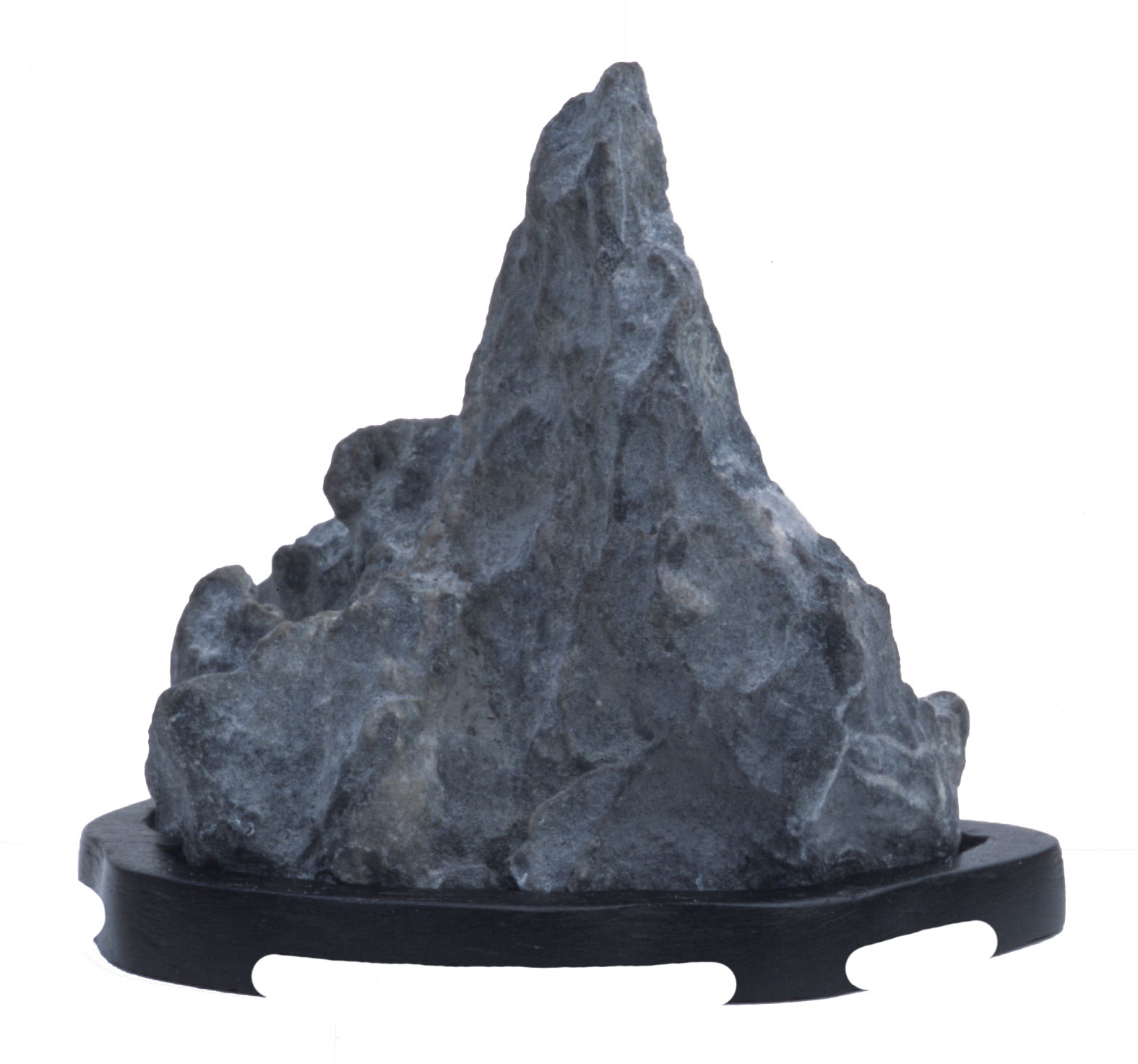
When I named “Mt. Everest,” there were no well-to-do tourists standing in long lines for a guided trip to the top. The base is ebony and it has no legs, on the theory that as little as possible of the vertical space should be taken up by legs. Twenty years later, I realized it might have been possible to have very short legs, like the shelter stone, and not diminish the proportions. So I created them with the computer. Having learned that designing trees with the computer saved a lot of errors, I figured the idea could be applied to bases.
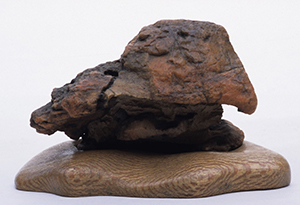
The stone in the lower left of the 7-stone display stand is a hut stone, a hard-to-find and very desirable stone. It deserves a closer look. The roof is a harder stone than the walls and did not weather as much. The base is Lacewood.
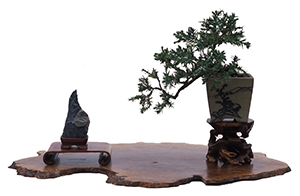
Although the next display is set up as if it were at a show, it was never shown. Unfortunately, both visitors at shows and a few club members had light fingers, and when you know the stone and stand are only 2 1/4” tall, you can see how easy it would be to walk out with the stone. I finally solved the problem of displaying small items by borrowing covers for displays from the Mingei International Museum in San Diego.
Like the hut stone, the mountain spire thrusting up through the clouds deserves a closer look. The base is Purple Heart.
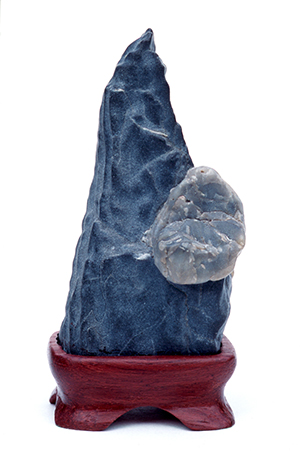
Although San Diego is a desert, during the winter I can drive 70 miles and find snow in the Laguna Mountains or drive twice that and ski at Mammoth in the Sierra. Not quite the same as skiing at Mont Tremblant in Canada or Stowe in Vermont, but nevertheless good for an adrenaline rush. Here’s a vista from the Sierra Madre showing the last of the spring snow, with a base from 100-year-old Poplar.
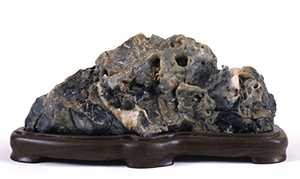
Murphys, CA is well-known for having been an early gold-mining town, for being the location of annual wine tastings and festivals, and for being in Calaveras County, the location of Mark Twain’s story “The Jumping Frog of Calaveras County.” To the stone collector, it is known as the source of Murphys’ Stones.
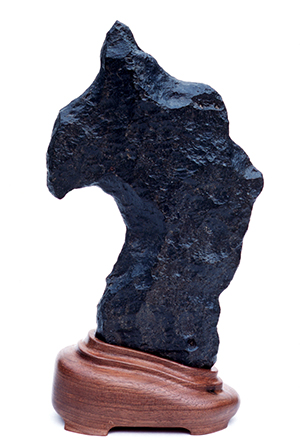
The brown is quartz and the blue-gray is limestone, very similar in color to the ying rock of China. This Murphys’ stone is called “Matterhorn; the base is Sapele.
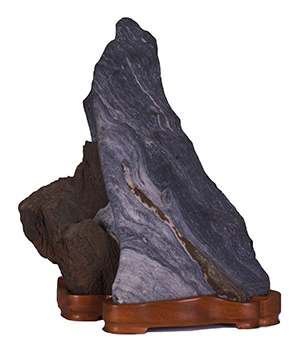
The question mark on its Walnut base looks like the tip from a soldier’s pike. That’s the way it came from the ground; nothing was done to it to make this shape. At 5.75” tall, it balances nicely. Compare it to the Matterhorn, which is 14” tall. Neither the Pike nor the Matterhorn has been cut; the daiza for both were carefully shaped to fit the bottom of the stones.
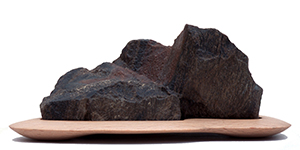
If you look carefully at the stone I call “Rocky Mountain,” you can see striations running almost vertically, as if the earth had heaved and pushed the stones to a nearly upright position. You would be wrong. The striations are growth rings in a piece of petrified wood. Is petrified wood stone? Stones are lithified, that is, sediments undergo physical and chemical changes that cause soils, clays, loose sand and gravels to consolidate. That’s what happens when wood is petrified.
The base is from a thrift store remnant, genealogy unknown.
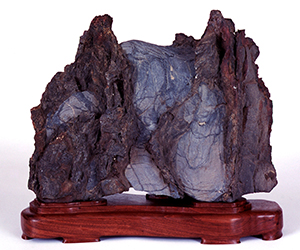
Since Murphys’ stones are so hard to find–collecting areas have mostly been closed off–I thought a second example might be in order. For obvious reasons, it is named “Twin Peaks.” The base is Black Walnut; the feet are under areas where the most weight is borne. So far as I know, the only way to get a Murphys’ stone now is to buy if from someone who owns one.
NB: None of the stones shown here were oiled or waxed. Some of the stones were cut to show a particular feature; some of the stones were not cut. Stone cutting has a long and respected history, starting in China.
Some tips for beginners: Flat-bottomed stones are easier to set in a base. If you want to cut a stone, stone-cutting saw blades are readily available. Use eye protection.
If you want to fit a stone, either freehand or with a pantagraph machine, make a mold of the bottom of the stone, using either plaster or children’s clay. In either case, put plastic wrap over the mold material before setting the stone in place. If the stone flares out at the bottom, don’t cover the flair as you will just have to remove the material above it to remove the stone. If you are freehand carving, you must look at the mold and then decide how much and where to cut. As a short cut, you can carve the first half inch or so from the model, but then you can scoop out the bottom so there is no further contact between the stone and the wood. If you want to be precise, you can be like a dentist, setting the stone in place over carbon paper and then cutting where there are evidences of carbon. A pantograph machine follows the mold itself.
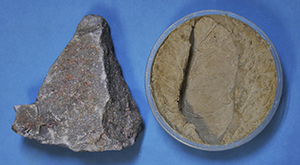
Left, the shadow at the bottom of the stone and the shadow at the left of the plaster mold show the lowest part of the stone. Right, the California desert stone is sitting in adobe that will dry to be hard as a brick. With the advent of 3-D printing, it may be possible to print stands or inserts that can be fitted into the wood of your choice.
Annotated Bibliography
First is a book that doesn’t even have stone in its title. Joseph Conder, a British architect, went to Japan in 1877 and learned to speak and read Japanese fluently. One of his sources dated to 1633 and he had wide access to others. To me, the book explains the symbolism of stones, certainly in Japan if not elsewhere.
Conder, Joseph, Landscape Gardening in Japan, Kodansha International Ltd., Tokyo, 2002.
I suggest that you go to <www.virtual-suiseki-museum.org/books.html> Eleven books, including the six books below marked with asterisks, are shown there as of November 15, 2014.
*Covello, Vincent T. and Yoshimura, Yuji, The Japanese Art of Stone Appreciation: Suiseki and Its Use with Bonsai. Charles E. Tuttle Company, Rutland, Vermont, 1984.
This is the seminal book in the U. S. on suiseki. Quite a number of bonsai artists in the U. S. studied with Yoshimura. The current edition has a foreword by Dr. Sonya Arnitzen, Professor Emerita of Classical Japanese Literature at the University of Toronto.
*Tucker, Melba L., Suiseki Viewing Stones: An American Experience, Horizons West, Flagstaff Arizona, 1996. [Exquisitely photographed by Peter L. Bloomer.]
Melba Tucker was an outstanding California bonsai artist who extended her love for trees to stones and became an outstanding collector. She explains “It is no surprise that interest in and desire for suiseki often accompanies a love of bonsai. After caring for bonsai for many years, a person naturally develops an eye for these representations of nature in miniature.”
Many of her stones are from the California desert, including the Lake Hill area. Quite a number of her stones went to the National Bonsai Arboretum and are displayed in rotation. She died not long after the book was published so there are no new editions.
*The National Bonsai and Penjing Museum, Awakening the Soul, The National Bonsai Foundation, Washington, D.C., 2000. [Dedicated to Yuji Yoshimura; exquisitely photographed.]
*Hu, Kemin, The Spirit of Gongshi: Chinese Scholar’s Rocks, Art Media Resources, Ltd., Chicago, IL, nd. Minor portions of this book are printed in both English and Chinese. Excellent photos.
*Benz, Willi, The Art of Suiseki: Classical Japanese Stone Gardening, Sterling Publishing Company, Inc., New York, New York, 1996. Originally published in Germany.
Willi Benz was a force of nature both in suiseki and bonsai. In the foreword of his book, he quotes an ancient Chinese saying, “Nature reveals its wonders only to the one who keeps bonsai and suiseki in his heart.” He served on various German and European suiseki and bonsai associations and was on the Board of Bonsai Clubs International.
His personal collection of suiseki was extensive and came from many parts of the world. Exceptional photographs of outstanding suiseki, helpful information on collecting, preparing, displaying, even on how to make daiza, and a host of other observations make this an excellent resource.
*Phan, Van Lit, with Buller, Lew, Mountains in the Sea: The Vietnamese Miniature Landscape Art of Hon Non Bo, Timber Press, Inc., Portland, Oregon, 2001
The karst landscapes with their soaring mountains and deep valleys provided inspiration not only for the paintings and suiseki (penjing) of China, but also of Viet Nam. Vietnamese suiseki are called Hon Non Bo and range from small to very large, including those in public areas. Sacred and spiritual places often serve as models.
Lit Phan was a refugee from the Vietnamese war who found his way to the U. S and was joined by his family later. We formed a working partnership; he designed and built and I made large concrete pots, photographed, and typed, learning to type Vietnamese so small portions of the material using Vietnamese could be read by native speakers. You can find a review of the book in the Vietnamese Wikipedia, written by a bilingual psychiatrist from San Diego.
